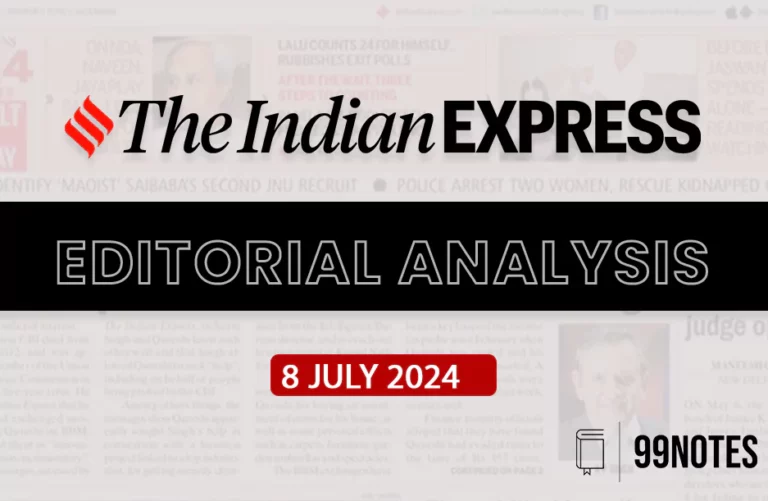23 August 2024 : The Hindu Editorial Analysis
1. Building on favourable change in the 2024 waqf Bill
(Source – The Hindu, International Edition – Page No. – 8)
| Topic: GS2 – Indian Polity |
| Context |
|
The Waqf (Amendment) Bill, 2024: A Critical Analysis
- The Waqf (Amendment) Bill, 2024, has been referred to a Joint Parliamentary Committee (JPC) after both the opposition and some allies of the Modi government expressed concerns.
- The Bill proposes changes that grant additional powers to the District Magistrate and abolish waqf by a user, which critics argue could lower protections for waqf properties.
- Though the Bill does little to address the illegal encroachment of waqf properties, it includes positive reforms like waqf digitisation and the inclusion of women and non-Muslims in waqf boards.
The Rationale Behind Family Waqf
- Concept of Waqf: Although the Quran does not use the term “waqf,” there are approximately 20 verses that encourage charity. Waqf is a form of Islamic charity where property becomes inalienable, and only its benefits (usufruct) can be used.
- Types of Waqf:
- Waqf Khari (Public Waqf): Devoted entirely to humanitarian causes.
- Waqf al-Ahli (Family Waqf): Benefits the family of the founder.
- Waqf al-Mushtarak (Public and Family Waqf): Combines both family and public benefits.
- Significance of Family Waqf: The family waqf has theological backing, as family members are prioritised in charity according to Islamic principles (Quran 2:215). This practice aligns with the concept that charity begins at home.
Purpose of Family Waqf
- Protection of Property: Family waqfs were traditionally used to prevent the fragmentation of agrarian land and protect property from prodigal heirs.
- Benefiting Vulnerable Groups: Family waqfs allowed founders to support orphaned grandchildren, aged parents, and minor or disabled children. In some cases, daughters were made primary beneficiaries, although, in other instances, women were excluded.
Criticism and Evolution of Family Waqf
- Scholarly Criticism: Scholars like Murat Cizakca and Gregory Kozlowski argue that family waqfs were used to avoid women’s inheritance rights. However, they also addressed loopholes in Islamic inheritance law by allowing grandfathers to provide for orphaned grandchildren.
- Colonial Influence: The British Privy Council invalidated family waqfs in 1894 but reversed the decision in 1913. Several Muslim countries, influenced by colonialism, restricted or abolished family waqfs. Egypt and Syria were among the first to restrict or abolish them, while countries like India and Bangladesh allowed family waqfs but did not offer them the same tax benefits as public waqfs.
Legal and Tax Treatment of Family Waqf in India
- Limited Benefits: The Income-Tax Act, 1961, exempts religious and charitable waqfs, but family waqfs must pay taxes. Estate duty applies to family waqfs, and properties passing between beneficiaries are subject to taxation.
- Waqf Act of 1995: Section 2(1)(r) of the Waqf Act includes family waqfs in its definition, stating that when the line of succession fails, the income should be used for education and welfare.
Proposed Changes in the Waqf (Amendment) Bill, 2024
- Section 3A(2): This section proposes reforms ensuring that family waqfs do not deny heirs, including female heirs, their inheritance rights. The founder can only create a family waqf with up to one-third of their property if excluding all heirs. However, if female heirs are given token benefits, less than their legal entitlement, the waqf would still remain valid.
- Challenges of Uniform Application: There is a concern about whether similar restrictions on inheritance rights should apply to non-Muslims. For example, under the Hindu Succession Act, a Hindu can leave their entire estate to one son, excluding female heirs, which highlights the lack of property ownership among Hindu women.
Conclusion and Recommendations
- The JPC could improve these provisions by addressing the unequal treatment of heirs and ensuring fairness across religious groups.
- The inclusion of these reforms in a future Uniform Civil Code or Secular Civil Code would standardise inheritance rights.
| Practice Question: Critically analyse the key provisions of the Waqf (Amendment) Bill, 2024, with a focus on its impact on family waqfs and inheritance rights. How does it address concerns related to gender equality and property protection? (150 Words /10 marks) |
2. Do we need a Central law for protection of healthcare professionals?
| Topic: GS2 – Social Justice – Health |
(Source – The Hindu, International Edition – Page No. – 9)
| Context |
|
Do We Need a Central Law for the Protection of Healthcare Professionals?
- The recent rise in violence against healthcare professionals across India has brought the need for stronger legal protection into sharp focus.
- The discussion on whether a Central law is necessary has resurfaced, especially after multiple incidents of violence, including the recent brutal attack on a trainee doctor.
- The article delves into the arguments for and against the need for a Central law to protect healthcare workers.
Rising Violence Against Healthcare Workers
- Increasing Incidents: Violence against healthcare workers has been on the rise in India for the last two to three decades, often triggered by factors such as unexpected deaths, miscommunication, or high medical costs.
- Root Causes:
- High Expectations: Patients and their families expect immediate and often unrealistic outcomes, which leads to frustration when those expectations are unmet.
- Healthcare Costs: The high out-of-pocket expenditure in India’s healthcare system adds to the pressure, often resulting in emotional outbursts against healthcare workers.
- Lack of Infrastructure: The healthcare system’s inefficiencies, especially in public hospitals, contribute to long wait times and limited access to quality care, further exacerbating tensions.
Need for Better Infrastructure and Security Measures
- Workforce Overload: Many hospitals, especially government facilities, rely heavily on interns and postgraduate medical students, who are often overworked and emotionally exploited.
- Security Protocols: Strengthening security in hospitals is essential. Recommendations include:
- Installing CCTV cameras.
- Ensuring the presence of accountable security personnel.
- Establishing hospital protection committees to oversee the safety of healthcare workers.
- Communication and Mental Health Support: Improved communication between doctors and patients is crucial to avoid misunderstandings, while addressing the mental health of medical staff, especially postgraduate students, is also vital.
Existing Laws and the Need for a Central Legislation
- State-Level Laws: Around 25 states have enacted laws aimed at protecting healthcare professionals, but there are very few convictions under these laws, signalling a gap in enforcement.
- Previous Attempts: In 2019, the central government drafted the ‘Healthcare Service Personnel and Clinical Establishments (Prohibition of violence and damage to property) Bill’. However, it was not passed due to concerns over whether existing state and central laws were sufficient.
- Central vs. State Jurisdiction: Health and law enforcement are primarily state subjects under India’s federal system. However, advocates for a Central law argue that national legislation would standardise the protection of healthcare workers across the country and provide much-needed enforcement consistency.
Supreme Court’s Involvement and the IMA’s Viewpoint
- Supreme Court’s Task Force: The Supreme Court has established a national task force to examine the safety of healthcare workers, focusing on improving working conditions and security measures. However, this initiative does not address the need for a deterrent law.
- Lack of Convictions: Despite the existence of state laws, there have been very few convictions related to violence against healthcare workers, raising questions about the effectiveness of these laws in preventing such incidents.
The Case for a Central Law
- Deterrent Effect: A well-drafted Central law, with strong provisions linked to the Indian Penal Code and the Code of Criminal Procedure, could act as a significant deterrent to violence against healthcare professionals.
- Kerala’s Example: Kerala’s recent amendments to its healthcare protection laws, following the tragic death of a medical professional, have shown that stringent laws backed by swift police action can reduce the incidence of violence.
- Balancing Stakeholder Rights: A Central law must strike a balance between protecting healthcare workers and ensuring that patient rights are not compromised. Strengthening the public health system and reducing out-of-pocket expenditure are equally important to address the root causes of violence.
Conclusion
- While improving hospital infrastructure, enhancing security measures, and increasing public healthcare spending are critical, a Central law could provide the legal framework needed to ensure the safety of healthcare professionals across the country.
| Practice Question: Discuss the need for a Central law to protect healthcare professionals in India, considering the rising incidents of violence despite existing state laws. (250 Words /15 marks) |



